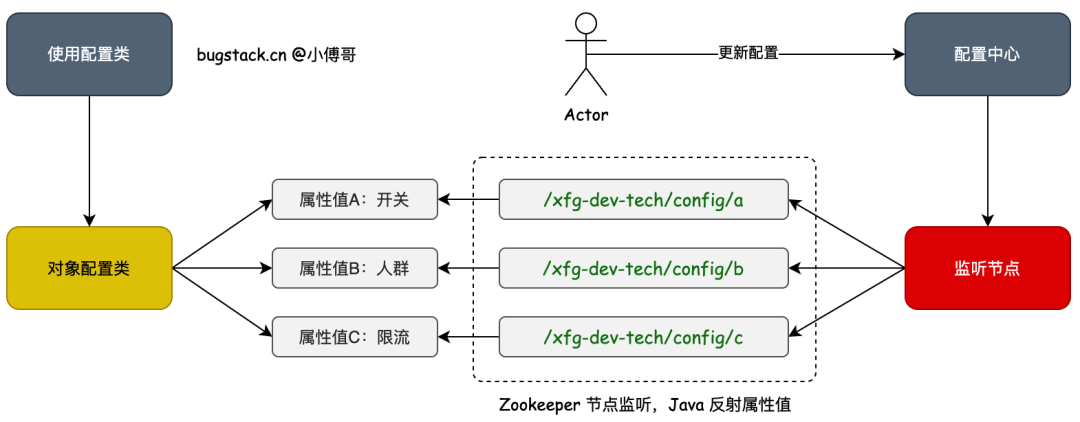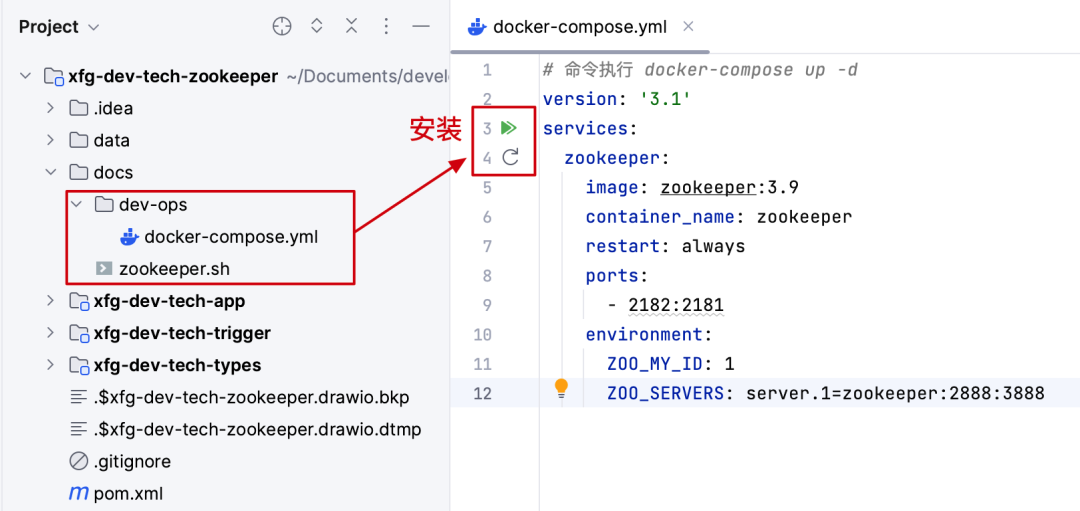本文的宗旨在于通过简单干净实践的方式,向读者介绍 Zookeeper 的安装配置,学习 SpringBoot 整合使用,以及基于 Zookeeper 开发一个简单的配置中心功能内核。通过这样的实践方式,让读者入门和掌握 Zookeeper 以应对后续需要此技术栈的相关开发项目。
本文的重点是基于 Zookeeper 实现的配置中心,那配置中心是啥呢?
配置中心在大厂系统开发中是一个非常常用的功能,它的核心功能在于不需要上线系统的情况下,改变系统中对象或者属性的值。是属性的值,也就是你在通过类获取某个属性,判断;功能开关、渠道地址、人群名单、息费费率、切量占比等等,这些可能随时动态调整的值,都是通过配置中心实现的。所以在本章节的案例中,小傅哥基于 Zookeeper 组件的功能特性,来设计这样一个配置中心,方便大家学习。
本文涉及的工程:
- xfg-dev-tech-zookeeper:https://gitcode.net/KnowledgePlanet/road-map/xfg-dev-tech-connection-pool - docs/dev-ops 提供了 Zookeeper 安装脚本。
一、配置中心
Zookeeper 有什么特性,动态配置中心怎么做?
技术是支撑解决方案实现的,有了各个技术栈组件的自身特点,才好实现出我们所需的各类功能。那么这样的一个能让,各个服务都可以动态变更配置的配置中心,就要用到 Zookeeper 的节点监听和节点值的变化来动态设置 Java 类中属性的变化。如图:
 图片
图片
- 首先,我们需要定义出一个 Zookeeper 监听的配置路径,一般这个路径在配置中心中是申请的系统使用地址,以确保值的唯一。
- 之后,每个类对应的属性,需要映射出一个监听的节点。比如;Zookeeper 监听了 /xfg-dev-tech/config 那么类中 a 属性可以是 /xfg-dev-tech/config/a 这对这个路径设置的值,就可以被监听拿到了。
- 最后,把获取到的监听值,通过 Java 反射操作,把值设置到对应的属性上。这样在 SpringBoot 应用程序中,使用某个类的属性值的时候,就可以动态的获取到变化的属性值了。
二、环境配置
在安装执行 docker-compose.yml 脚本之前,你需要先在本地安装 docker 之后 IntelliJ IDEA 打开 docker-compose.yml 文件,如图操作即可安装。
 图片
图片
 图片
图片
- 另外,如果你是在服务器上安装,则需要执行 docker-compose -f docker-compose.yml up -d 并且是你已经安装了 Docker-Compose 包。—— 这些内容在小傅哥的《Java 简明教程》中都有讲解,可以进入学习。
三、基本使用
连接脚本:
docker exec -it zookeeper bash
zkCli.sh -server IP(替换为你自己的):2181常用命令:
1. 创建节点:create /path data
2. 创建临时节点:create -e /path data
3. 创建顺序节点:create -s /path data
4. 创建临时顺序节点:create -e -s /path data
5. 获取节点数据:get /path
6. 获取节点子节点列表:ls /path
7. 更新节点数据:set /path data
8. 删除节点:delete /path
9. 删除节点及其子节点:deleteall /path
10. 监听节点变化:get -w /path
11. 查看节点状态:stat /path
12. 查看节点ACL权限:getAcl /path
13. 设置节点ACL权限:setAcl /path acl
14. 查看节点子节点数量:count /path
15. 查看节点子节点数量并监听变化:count -w /pathroot@4365b68d50d6:/apache-zookeeper-3.9.0-bin# ls
bin conf docs lib LICENSE.txt NOTICE.txt README.md README_packaging.md
root@4365b68d50d6:/apache-zookeeper-3.9.0-bin# zkCli.sh -server 10.253.6.71:2181
[zk: 192.168.1.101:2181(CONNECTED) 1] ls /xfg-dev-tech
[config, configdowngradeSwitch]
[zk: 192.168.1.101:2181(CONNECTED) 2]执行完链接 Zookeeper 以后,就可以执行这些常用命令了。你也可以尝试着练习下这些命令。
四、功能实现
1. 工程结构
 图片
图片
工程结构分为2个部分:
- app 启动层的 config 包下,用于提供 Zookeeper 服务的启动配置。以及小傅哥在这里新添加的功能 DCCValue 配置中心模块。
- trigger 是触发器,这里吧 http 请求、listener 监听,都是放到这里使用。另外像 MQ、JOB、RPC 也是放到这一层,以这一层触发,来调用我们的领域服务。
2. 启动 Zookeeper 服务
2.1 自定配置
@Data
@ConfigurationProperties(prefix = "zookeeper.sdk.config", ignoreInvalidFields = true)
public class ZookeeperClientConfigProperties {
private String connectString;
private int baseSleepTimeMs;
private int maxRetries;
private int sessionTimeoutMs;
private int connectionTimeoutMs;
}2.2 使用配置
zookeeper:
sdk:
config:
connect-string: 10.253.6.71:2181
base-sleep-time-ms: 1000
max-retries: 3
session-timeout-ms: 1800000
connection-timeout-ms: 300002.3 配置服务
@Configuration
@EnableConfigurationProperties(ZookeeperClientConfigProperties.class)
public class ZooKeeperClientConfig {
/**
* 多参数构建ZooKeeper客户端连接
*
* @return client
*/
@Bean(name = "zookeeperClient")
public CuratorFramework createWithOptions(ZookeeperClientConfigProperties properties) {
ExponentialBackoffRetry backoffRetry = new ExponentialBackoffRetry(properties.getBaseSleepTimeMs(), properties.getMaxRetries());
CuratorFramework client = CuratorFrameworkFactory.builder()
.connectString(properties.getConnectString())
.retryPolicy(backoffRetry)
.sessionTimeoutMs(properties.getSessionTimeoutMs())
.connectionTimeoutMs(properties.getConnectionTimeoutMs())
.build();
client.start();
return client;
}
}- 这样我们就可以启动一个 Zookeeper 的客户端了,自定义可以更好的控制和使用。
3. 定义注解
就功能来讲,我们需要对类中的属性进行赋值操作。那么就需要使用自定义注解进行标记。所以这里我们先自定义一个注解。
@Retention(RetentionPolicy.RUNTIME)
@Target({ElementType.FIELD})
@Documented
public @interface DCCValue {
String value() default "";
}- 这样所有使用了 @DCCValue 的注解的字段就都可以被我扫描到了。
4. 监听变化
4.1 获取属性
源码:cn.bugstack.xfg.dev.tech.config.DCCValueBeanFactory#postProcessAfterInitialization
@Override
public Object postProcessAfterInitialization(Object bean, String beanName) throws BeansException {
Class<?> beanClass = bean.getClass();
Field[] fields = beanClass.getDeclaredFields();
for (Field field : fields) {
if (field.isAnnotationPresent(DCCValue.class)) {
DCCValue dccValue = field.getAnnotation(DCCValue.class);
try {
if (null == client.checkExists().forPath(BASE_CONFIG_PATH.concat("/").concat(dccValue.value()))) {
client.create().creatingParentsIfNeeded().forPath(BASE_CONFIG_PATH.concat("/").concat(dccValue.value()));
log.info("DCC 节点监听 listener node {} not absent create new done!", BASE_CONFIG_PATH.concat("/").concat(dccValue.value()));
}
} catch (Exception e) {
throw new RuntimeException(e);
}
dccObjGroup.put(BASE_CONFIG_PATH.concat("/").concat(dccValue.value()), bean);
}
}
return bean;
}- DCCValueBeanFactory 实现了 BeanPostProcessor 接口的 postProcessAfterInitialization 方法。
- 在实现中,通过对 bean 对象的解析获取到使用 DCCValue 注解属性,并判断这个属性拼接的地址是否在 Zookeeper 中创建,如果没有则创建。之后保存对象到内存中。
4.2 设置属性
源码:cn.bugstack.xfg.dev.tech.config.DCCValueBeanFactory#DCCValueBeanFactory
curatorCache.listenable().addListener((type, oldData, data) -> {
switch (type) {
case NODE_CHANGED:
String dccValuePath = data.getPath();
Object objBean = dccObjGroup.get(dccValuePath);
try {
// 1. getDeclaredField 方法用于获取指定类中声明的所有字段,包括私有字段、受保护字段和公共字段。
// 2. getField 方法用于获取指定类中的公共字段,即只能获取到公共访问修饰符(public)的字段。
Field field = objBean.getClass().getDeclaredField(dccValuePath.substring(dccValuePath.lastIndexOf("/") + 1));
field.setAccessible(true);
field.set(objBean, new String(data.getData()));
field.setAccessible(false);
} catch (Exception e) {
throw new RuntimeException(e);
}
break;
default:
break;
}
});- 基于 Zookeeper 对节点的监听,只要这个节点上有值发生变化。就可以立刻检测到对应的路径信息和值信息。
- 那么拿到这个值信息,就可以把值写入到对应的属性上了。如类.A = Zookeeper 获取到的值
五、功能使用
源码:cn.bugstack.xfg.dev.tech.trigger.http.ConfigController
@RestController
public class ConfigController {
@DCCValue("downgradeSwitch")
private String downgradeSwitch;
@DCCValue("userWhiteList")
private String userWhiteList;
@Resource
private CuratorFramework curatorFramework;
/**
* curl http://localhost:8091/getConfig/downgradeSwitch
*/
@RequestMapping("/getConfig/downgradeSwitch")
public String getConfigDowngradeSwitch() {
return downgradeSwitch;
}
/**
* curl http://localhost:8091/getConfig/userWhiteList
*/
@RequestMapping("/getConfig/userWhiteList")
public String getConfigUserWhiteList() {
return userWhiteList;
}
/**
* curl -X GET "http://localhost:8091/setConfig?downgradeSwitch=false&userWhiteList=xfg,user2,user3"
*/
@GetMapping("/setConfig")
public void setConfig(Boolean downgradeSwitch, String userWhiteList) throws Exception {
curatorFramework.setData().forPath("/xfg-dev-tech/config/downgradeSwitch", (downgradeSwitch ? "开" : "关").getBytes(StandardCharsets.UTF_8));
curatorFramework.setData().forPath("/xfg-dev-tech/config/userWhiteList", userWhiteList.getBytes(StandardCharsets.UTF_8));
}
}这里的核心验证就是让 downgradeSwitch、userWhiteList 这2个属性值可以动态变化;
- 在两个属性上添加注解后,就会被扫描和管理。
- 获取值方法:http://localhost:8091/getConfig/downgradeSwitch、http://localhost:8091/getConfig/userWhiteList
- 设置值方法:http://localhost:8091/setConfig?downgradeSwitch=false&userWhiteList=xfg,user2,user3 - 这里的设置值操作不非得在这里,可以是一个单独的控制后台来操作。这里的方式主要是演示作用
 图片
图片
你可以按照如图的操作顺序,进行验证属性值的变化。
六、其他测试
@Slf4j
@RunWith(SpringRunner.class)
@SpringBootTest
public class ApiTest {
@Resource
private CuratorFramework curatorFramework;
@Test
public void test_all() throws Exception {
String path = "/xfg-dev-tech/config/downgradeSwitch";
String data = "0";
curatorFramework.create().withMode(CreateMode.EPHEMERAL).forPath(path, data.getBytes(StandardCharsets.UTF_8));
for (int i = 0; i < 2; i++) {
curatorFramework.setData().forPath(path, String.valueOf(i).getBytes(StandardCharsets.UTF_8));
}
}
/**
* 创建永久节点
*/
@Test
public void createNode() throws Exception {
String path = "/xfg-dev-tech/config/downgradeSwitch/test/a";
String data = "0";
if (null == curatorFramework.checkExists().forPath(path)) {
curatorFramework.create().creatingParentsIfNeeded().forPath(path);
}
}
/**
* 创建临时节点
*/
@Test
public void createEphemeralNode() throws Exception {
String path = "/xfg-dev-tech/config/epnode";
String data = "0";
curatorFramework.create().withMode(CreateMode.EPHEMERAL).forPath(path, data.getBytes(StandardCharsets.UTF_8));
}
/**
* 创建临时有序节点
*/
@Test
public void crateEphemeralSequentialNode() throws Exception {
String path = "/xfg-dev-tech/config/epsnode";
String data = "0";
curatorFramework.create()
.withMode(CreateMode.EPHEMERAL_SEQUENTIAL)
.forPath(path, data.getBytes(StandardCharsets.UTF_8));
}
/**
* 往节点种设置数据
*/
@Test
public void setData() throws Exception {
curatorFramework.setData().forPath("/xfg-dev-tech/config/downgradeSwitch", "111".getBytes(StandardCharsets.UTF_8));
curatorFramework.setData().forPath("/xfg-dev-tech/config/userWhiteList", "222".getBytes(StandardCharsets.UTF_8));
}
@Test
public void getData() throws Exception {
String downgradeSwitch = new String(curatorFramework.getData().forPath("/xfg-dev-tech/config/downgradeSwitch"), StandardCharsets.UTF_8);
log.info("测试结果: {}", downgradeSwitch);
String userWhiteList = new String(curatorFramework.getData().forPath("/xfg-dev-tech/config/userWhiteList"), StandardCharsets.UTF_8);
log.info("测试结果: {}", userWhiteList);
}
/**
* 异步修改数据
*/
@Test
public void setDataAsync() throws Exception {
String path = "/xfg-dev-tech/config/downgradeSwitch";
String data = "0";
CuratorListener listener = (client, event) -> {
Stat stat = event.getStat();
log.info("stat=" + JSON.toJSONString(stat));
CuratorEventType eventType = event.getType();
log.info("eventType=" + eventType.name());
};
curatorFramework.getCuratorListenable().addListener(listener);
curatorFramework.setData().inBackground().forPath(path, data.getBytes(StandardCharsets.UTF_8));
}
/**
* 删除节点
*/
@Test
public void deleteData() throws Exception {
String path = "/xfg-dev-tech/config/downgradeSwitch";
curatorFramework.delete().deletingChildrenIfNeeded().forPath(path);
}
/**
* 安全删除节点
*/
@Test
public void guaranteedDeleteData() throws Exception {
String path = "/xfg-dev-tech/config/downgradeSwitch";
curatorFramework.delete().guaranteed().forPath(path);
}
/**
* 获取子节点下的全部子节点路径集合
*/
@Test
public void watchedGetChildren() throws Exception {
String path = "/xfg-dev-tech";
List<String> children = curatorFramework.getChildren().watched().forPath(path);
log.info("测试结果:{}", JSON.toJSONString(children));
}
/**
* 获取节点数据
*/
@Test
public void getDataByPath() throws Exception {
String path = "/xfg-dev-tech/config/downgradeSwitch";
String fullClassName = "";
String jsonStr = new String(curatorFramework.getData().forPath(path), StandardCharsets.UTF_8);
Class clazz = Class.forName(fullClassName);
log.info("测试结果:{}", JSON.parseObject(jsonStr, clazz));
}
}- 这些功能也都可以测试验证,也是平常用的较多的东西。
七、其他资料
- Zookeeper Web UI:https://zoonavigator.elkozmon.com/en/latest/
- 官网文档:https://zookeeper.apache.org/doc/r3.5.0-alpha/zookeeperAdmin.html









































